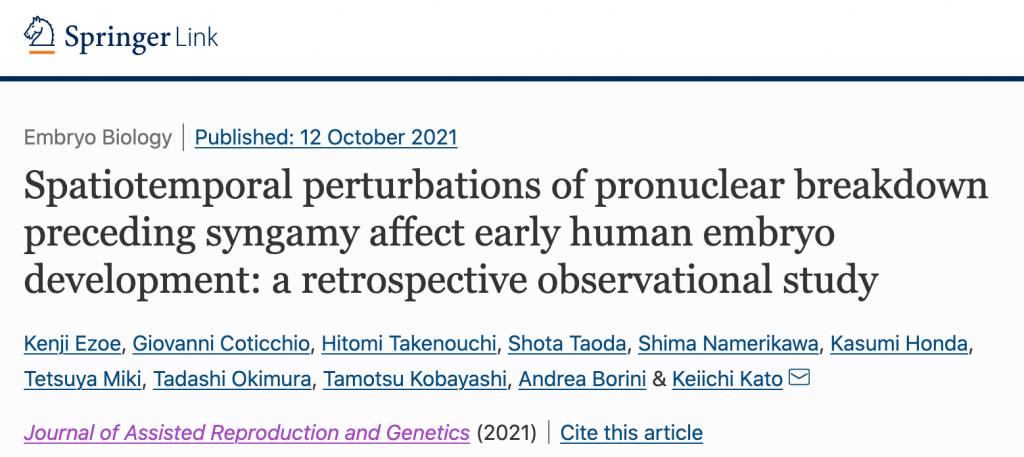
Spatiotemporal perturbations of pronuclear breakdown preceding syngamy affect early human embryo development: a retrospective observational study
Kenji Ezoe, Giovanni Coticchio, Hitomi Takenouchi, Shota Taoda, Shima Namerikawa, Kasumi Honda, Tetsuya Miki, Tadashi Okimura, Tamotsu Kobayashi, Andrea Borini, Keiichi Kato
Journal of Assisted Reproduction and Genetics. 2021 Oct 12. doi: 10.1007/s10815-021-02335-6.
Abstract
Purpose: During fertilisation, female and male pronuclei (PNs) migrate to the centre of the ooplasm, juxtapose, and break down synchronously in preparation for the first mitosis. While PN non-juxtaposition and PN breakdown (PNBD) asynchrony are occasionally observed, their developmental implications remain uncertain. This study investigated the possible relationships among the two phenomena, preimplantation development patterns, and live birth rates in single blastocyst transfers.
Methods: A total of 1455 fertilised oocytes cultured in a time-lapse incubator were retrospectively analysed. Fertilised oocytes were divided into four groups according to the presence of PN juxtaposition and breakdown synchrony. The relationships of abnormal PN behaviour with embryo morphokinetics, blastocyst formation, and live birth were evaluated.
Results: PN non-juxtaposition and asynchrony were observed in 1.9% and 1.0% of fertilised oocytes, respectively. The blastocyst cryopreservation rates in the synchronous–non-juxtaposed and asynchronous–non-juxtaposed groups were significantly lower than that in the synchronous–juxtaposed group. The rates of clinical pregnancy, ongoing pregnancy, and live birth were comparable among the groups. Non-juxtaposition was significantly associated with increased trichotomous cleavage at the first cytokinesis (P < 0.0001) and an increase in the time interval from PNBD to first cleavage (P < 0.0001). Furthermore, asynchronous PNBD was significantly correlated with increased rapid cleavage at the first cytokinesis (P = 0.0100).
Conclusion: Non-juxtaposition and asynchronous PNBD is associated with abnormal mitosis at the first cleavage and impaired preimplantation development. However, embryos displaying abnormal PNBD may develop to blastocyst stage and produce live births, suggesting blastocyst transfer as a more appropriate culture strategy.

